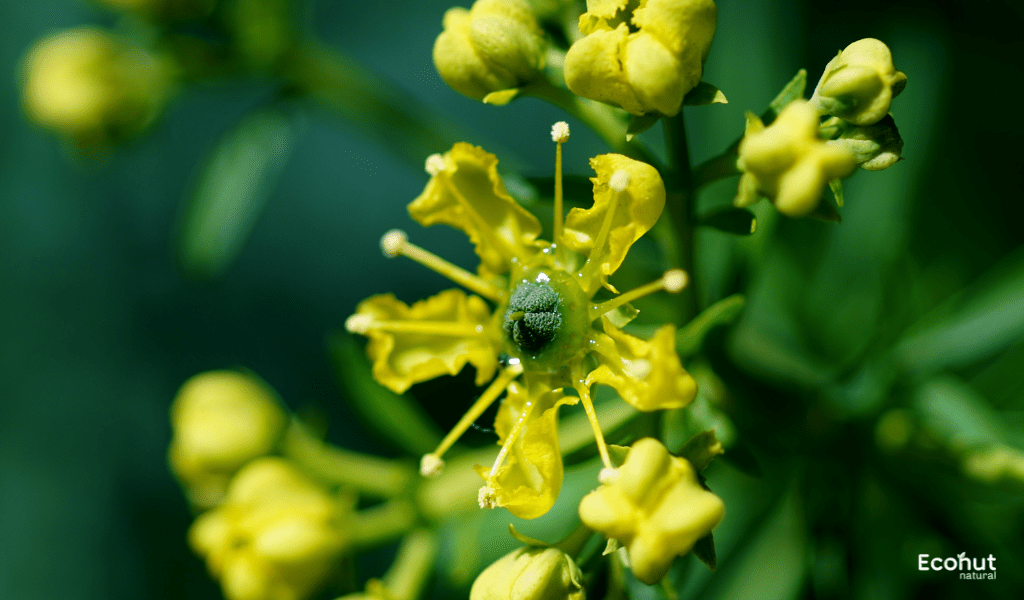Common Rue (Ruta Graveolens) . Native to the Balkan Peninsula, it is. It is typically grown in gardens and has additional therapeutic properties. It was a well-known plant in antiquity and was utilized extensively for a variety of purposes, but with time its use declined because of its toxicity and bitter taste. This plant is widely planted because of its exceptional resistance to hot, dry weather.
It grows well in soil that is moist, well-drained, somewhat fertile, and in full sun to partial shade. This resilient plant can withstand drought, rocky, and dry soil, and it is resistant to deer. In northern zones, steer clear of moist soils and cover with mulch during the winter.
Description
Due to its blue-green foliage and ability to serve as a host plant for several swallowtail butterflies, rhubarb is typically grown as an ornamental. It can only exist for around five years, but during that time it will self-seed to regenerate.
Botanical Name:
Ruta Graveolens
Family:
Rutaceae
Leaves:
The leaves are bi- or tripinnate, bluish-green, and arranged alternately.
Flowers:
Little yellow flowers that bloom in clusters in late spring or early summer are produced by common rhubarb. The flowers are not particularly showy and have four or five petals.
Stems:
Common Rue plants have straight, woody stalks. As the plant ages, they can reach heights of two to three feet and begin to spread out. Initially smooth and green, the stems can mature to become brown and woody.
Seeds:
Common Rue seeds are tiny, glossy, and black. When the correct circumstances are met, they can easily germinate and are easily distributed by wind.
Habitat:
The Balkan Peninsula and the Mediterranean region are thought to be Common Rue’s natural habitats respectively. It grows here on the boundaries of woodlands, on hillsides, and in rocky places.
Parts Used:
- Leaves
Dosage
- Juice 5-10 ml
- Powder 1-3 g
- Infusion 10-20 ml
Chemical Constituents
Rutin, caprinic, plagonic, caprylic, and oenanthic acids are present in the plant’s volatile oil. Additionally, it contains skimmianine, a furoquinoline alkaloid that has been demonstrated to directly stimulate uterine tissue.
Sanskrit Synonyms
Sudava
Other Language Names of Common Rue (Ruta Graveolens)
Hindi name – Sitaba
Telugu name – Sadapaku
English name – Garden rue, Common rue
Tamil name – Aruvadana
Scientific Classification
| Kingdom | Plantae |
| Divison | Angiosperms |
| Class | Eudicots |
| Order | Sapindales |
| Family | Rutaceae |
| Genus | Ruta |
| Species | R.graveolens |
Ayurvedic Properties
Rasa – (taste) – Tikta – bitter
Guna (qualities) – Laghu – light to digest, Teekshna – strong,piercing
Vipaka – Katu – Undergoes pungent taste conversion after digestion
Veerya – Ushna – Hot potency
Common Rue (Ruta Graveolens) Uses
- This herb aids in clearing the skin’s complexion and gets rid of free radicals, which are the root cause of premature aging of the skin. It maintains skin healthy and youthful-looking.
- Its antifungal qualities aid in the treatment of dermatitis and athlete’s foot, two fungal infections of the skin. It is rarely applied directly to the skin because it can be poisonous in high concentrations; however in extreme situations, such as athlete’s foot, it can be. Applying common rue might offer immediate relief from skin irritation.
- Common Rue’s oil is used in spas to restore damaged hair, leaving it looking healthy and lustrous.
- It helps prevent infections caused by insects and pests by keeping them at bay because to its abundance of insecticide and pesticide properties. It can be used as an insect stick, vaporizer, or fumigant for this purpose.
- This plant works wonders for arthritis-related inflammation and pain. It eases joint and muscular pain.
Common Rue (Ruta Graveolens) Benefits
Insecticide:
Numerous diseases are brought on by pests like flies, cockroaches, and mosquitoes. Rue can be used to drive these insects away. To keep insects away, it can also be used as burners, fumigants, vaporizers, and incense sticks.
For Clear Skin:
Due to its antifungal qualities, it helps treat de-complexion and leave your skin looking clear and shiny. Rue’s antioxidant qualities keep your skin looking younger and more radiant by preventing free radicals from triggering premature skin aging. Rue oil is used in spas to create therapeutic face vapors for this reason.
Relieving Pain and Inflammation:
Excellent anti-inflammatory and antispasmodic qualities of Ruta Graveolens can aid in pain relief. You can drink it as a tea to relieve pain if you take the correct amount. It can help with sprains, arthritis, and shoulder pain. The study article supporting this assertion can be found here.
Ruta herb helps with menstrual cramps:
Women who experience severe menstrual cramps can find great relief from Ruta graveolens. Regular use of this herb relieves body pain and helps to alleviate severe menstrual cramps.
Anti-Inflammatory:
Rue can lessen inflammation primarily brought on either gout or arthritis. Because it contains vitamin C, inflammation can be lessened. Frequent use of one or two cups of rue herb tea relieves fever, sore joints, and tight muscles. Rue plant is also well-known for its expectorant qualities, which assist to open up the airways in your nose and reduce inflammation and upper respiratory tract infections
For Lice Free Hair:
An efficient pesticide found in rhubarb essential oil and extracts can help eradicate a lice infestation. Routinely using rue oil to your hair will keep the parasites away and stop your hair from itching.
Ruta graveolens for warts:
A well-known homeopathic remedy for flat, painful, and inflamed hand warts is ruta graveolens. However, the course of treatment can only be followed closely under a physician’s supervision.
Common Rue (Ruta Graveolens) Side Effects
Stomach irritation:
Rue can result in diarrhea, vomiting, nausea, and stomach pain.
Changes in mood:
Rue may result in hallucinations, vertigo, and difficulty sleeping.
Skin rash:
Rue can produce blisters and a rash, particularly if it is applied topically and subsequently exposed to sunlight.
Kidney and liver damage:
When taken in excess, rue can seriously harm the liver and kidneys.
Also Read: Rasona, Garlic (Allium Sativum)- Uses, Benefits and Side Effects
Conclusion
Ruta Graveolens has emerged as a natural health icon thanks to its extraordinary medicinal qualities. This herb has a lot of potential, from its antifungal and antibacterial qualities to its capacity to ease period cramps and lower stress levels. But before adding Ruta Graveolens to your wellness regimen, especially if you have specific medical conditions or are currently taking medication, it is imperative that you speak with medical professionals or Ayurvedic practitioners.
FAQS
What are the benefits of Common Rue?
To treat headaches and ear pain, crushed rue leaves are inserted into the ear canal. Rue is administered externally as a skin antibacterial, insect repellent, and poultice for rheumatic discomfort. Because of its toxicity, modern scientific herbalism (phytotherapy) no longer uses this plant.
What are the side effects of rue?
It may result in lightheadedness, sleepiness, and cramping. However, using oil or fresh leaves, or using a lot of dried leaves, is probably dangerous when it comes to rue. Serious adverse effects from them include vomiting, nausea, kidney damage, breathing difficulties, and even death.
What is Ruta graveolens used for?
Ruta graveolens L. (Rutaceae) is a medicinal herb that is commonly used in the Mediterranean region to treat rheumatism, dermatitis, pain, and other inflammatory illnesses.

